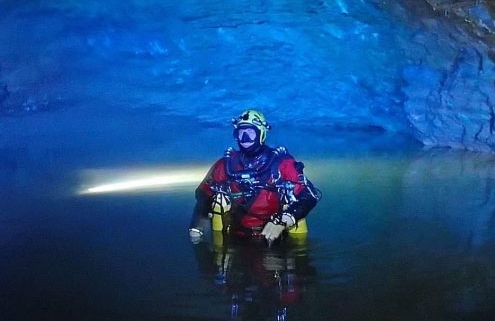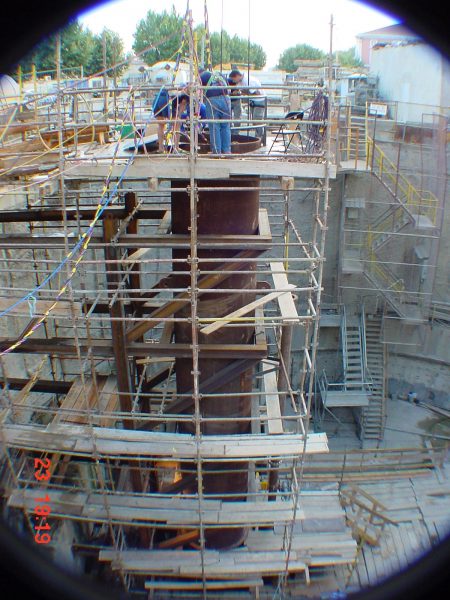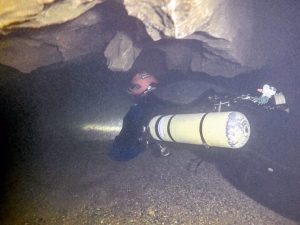Humans are not very good at going backwards!
Humans are not very good at going backwards!
By:Michael Thomas
TDI Full Cave Instructor and British Cave Diver
Robert Thomas TDI Full Cave and Sidemount Diver, Divemaster and Trainee Cave Diving Group Member.
Sometimes the art of survival requires thinking outside of the box. Working out your best options in times of stress can be difficult and not always obvious. Whilst training as a cave diver you should be taught the standards and basic rules of survival in the cave environment. Rules that started to be developed in the UK from the first cave dives in 1935 and eventually, after much trial and error, written into today’s standards and used around the world. If you have a problem during the dive such as a light failure or a gas supply issue the expected method is to deploy your backup light or swap regulators or even gas share, then turn your team around and head back to the entrance of the cave calmly, and as quickly as possible, fixing your problems on the surface so you can dive another day. You would never head back into the cave with a known problem, or would you?
Wookey Hole Cave in Somerset UK is the home of British Cave Diving. Diving operations started here in 1935 with Graham Balcombe and Penelope Powell pushing forward in heavy standard dress equipment from chamber three, finally reaching chamber seven, a distance underwater of around eighty metres. Since then the cave has been pushed to a depth of ninety metres beyond chamber 25 by Rick Stanton and John Volanthen in 2005 after many progressive exploration dives by many different divers.
The cave today still holds exploration potential but it is hard won to find new ground. Many trainee members of the cave diving group including young TDI Sidemount Cave Diver Robert Thomas regularly dive Wookey Hole for training and tourist dives. The training keeps our divers on the ball and when the cave is in condition it is a superb dive site with beautiful passage.
Wookey is a mixture of low bedding passage and high rift passage, as it follows the route up towards the caves on top of the Mendip Hills that feed Wookey with its waters, namely Swildons Hole and East Water Cavern. It changes depth many times from three metres to twenty two metres and back upto three metres and then back down to eighteen metres! It’s really not a fantastic dive profile. In fact it is an aggressive saw tooth profile but at least it’s not very deep!
On the day in question Robert and I had been asked by the show cave to assist in a photo shoot for the Show Cave part of Wookey which we duly did. As I was needed to stay stationary underwater close to the surface for some time and not disturb the waters for the photography I opted to use my Kiss Sidewinder MCCR. After the photo shoot Robert and I planned to swim up towards chamber twenty two as a tourist dive.
Between chamber three and twenty two are two possible routes, what we call the deep route (max depth 22m) and shallow route (max depth 16m.). A classic dive is to use the deep route on the way in and shallow route on the way out.
In the UK we have fixed line junctions, no gaps or jumps, so no need to deploy jump reels, all we do is mark the home side of the fixed junctions. In Wookey Hole the fixed junctions have permanent home markers so a round trip dive is very easy.
We dived upto chamber 22 using the deep route and returned along the shallow. At a point over half way home the cave passage drops from a depth of five metres back down to sixteen metres, you have to go this way to get out. Robert was in front moving along a small bedding plane passage and at the point of going down again he turns and signals that he can not equalise his left ear. This could be fun! If the ear won’t clear we have either to crash dive and potentially burst the ear drum or return back into the cave to surface in one of the dry chambers. Because I had opted to dive the MCCR on this day, we did actually have a lot of spare gas on us, even though Robert was on his second set of thirds, his outward planned gas. I still had two full cylinders of bailout gas on me. We spent some time moving slowly up and down trying to get the ear to clear but no joy. Considering the consequences of a ruptured ear on any dive let alone still being in the cave environment i.e. pain followed by nausea and loss of balance this was not our best option. We also did not have all day to come up with a solution!
I shouted into the Rebreather loop and signaled let’s return to chamber 20, this is a little air space that nobody uses anymore. It was back into the cave going the wrong way but has a surface and safe breathable atmosphere, it also has a dry route through boulders back into a new section of the show cave that was opened up a few years ago. My plan was that, if need be, Robert could climb out of the water and solo cave in his drysuit back to the show cave whilst I take his diving equipment back underwater to the dive base also solo.
The problem was this was only Robert’s fourth dive in the cave and he had never been to Wookey twenty, so making the decision to swim back into the cave to an unknown destination was mentally difficult knowing you are using your out gas to go back in. Doing everything your training tells you not to do.
As we turned to head back into the cave I was now in front and within a few minutes we surfaced in Wookey 20 much to Robert’s relief and also his ears relief. We discussed the problem on the surface and our options, both by now getting a little chilly in the 10.c water, after a gas check Robert decided to give diving another go and this time very slowly the left ear cleared and allowed us to swim back past the deep point and reach the dive base. On surfacing Robert had pain in the left ear and deafness that lasted until we got some decongestant from the local pharmacy.
As a cave diver some problems are occupational risks especially when you dive through a cave and surface, or have a cave with depth changes. The knowledge of the cave and all your available options can really help, even if the answer is not the most obvious one in the book. It really does pay you to research your dives or take a good guide.
Robert’s left ear was found to have a small infection by our doctor that was aggravated by an aggressive dive profile and the need to equalise many times during the dive. Medication and ear drops have since cleared the problem and we are back to diving with no problems. Another diving lesson learnt for all.
Robert Thomas describes below the incident in his words giving his perspective from the diver with the problem.
After having a great fun dive up to chamber twenty two we started our return journey. Getting back to the deep/shallow route split, we started our exit via the shallow route. This route is more restrictive than the deep route. Nothing tight, just a little bumpy in places. Almost impossible to keep good visibility, due to being in contact with the walls, floor and ceiling all the time. Just as I started my descent down to the last elbow of the shallow route my left ear blocked, at around five meters I felt it pressurise. Slowing down and trying to get it to clear had no effect, I eventually had to stop at around seven metres. Staying still for a while I tried to equalise hoping it would clear so I could continue onwards and exit with no major drama. It didn’t clear. My initial thoughts were slightly worried and relatively stressed in all honesty. I was already into my outwards third, although gas was not an issue as I was with my father who was on the sidewinder rebreather and effectively had two full open circuit cylinders available. After signalling that I had a problem I remember having to force myself to remain calm and think with logic and not the emotions of what could possibly be a tricky situation, clearing my mind and not allowing it to cloud my judgment. Although at no point did I feel close to panic, years of training works! However I felt there was a base level of concern present. In this situation we had options. However, if it was a system with only one entry/exit and the same problem occurred all you could do is crash dive and hope for the best, being aware of the side effects of a burst ear drum underwater and in a cave.
Making the decision to swim back into the cave was an odd one, but strangely not difficult to make. Although I knew about chamber twenty I could not exactly remember where it was so I followed Michael Thomas back to the air space. Knowing that the best option was swimming back into the system was actually quite a weird feeling, logic tells you that it’s the best thing to do in this situation, but your gut feeling of swimming further away from home when you have a problem isn’t nice. Luckily on the way back to twenty I felt the blockage clear. After surfacing and having a chat about what the plan was if my ear blocked again, we gave diving another go and were able to get back to the dive base via the deep route. Now our shortest but deeper way home.
The big lesson for me that I took from this is that having a good knowledge of your dive site is crucial when dealing with these situations. So if it’s a new site make sure you are doing your research. As well as being able to work backwards as the solution will not always be in front of you.
Dive safe and plan to fail well.






Leave a Reply
Want to join the discussion?Feel free to contribute!